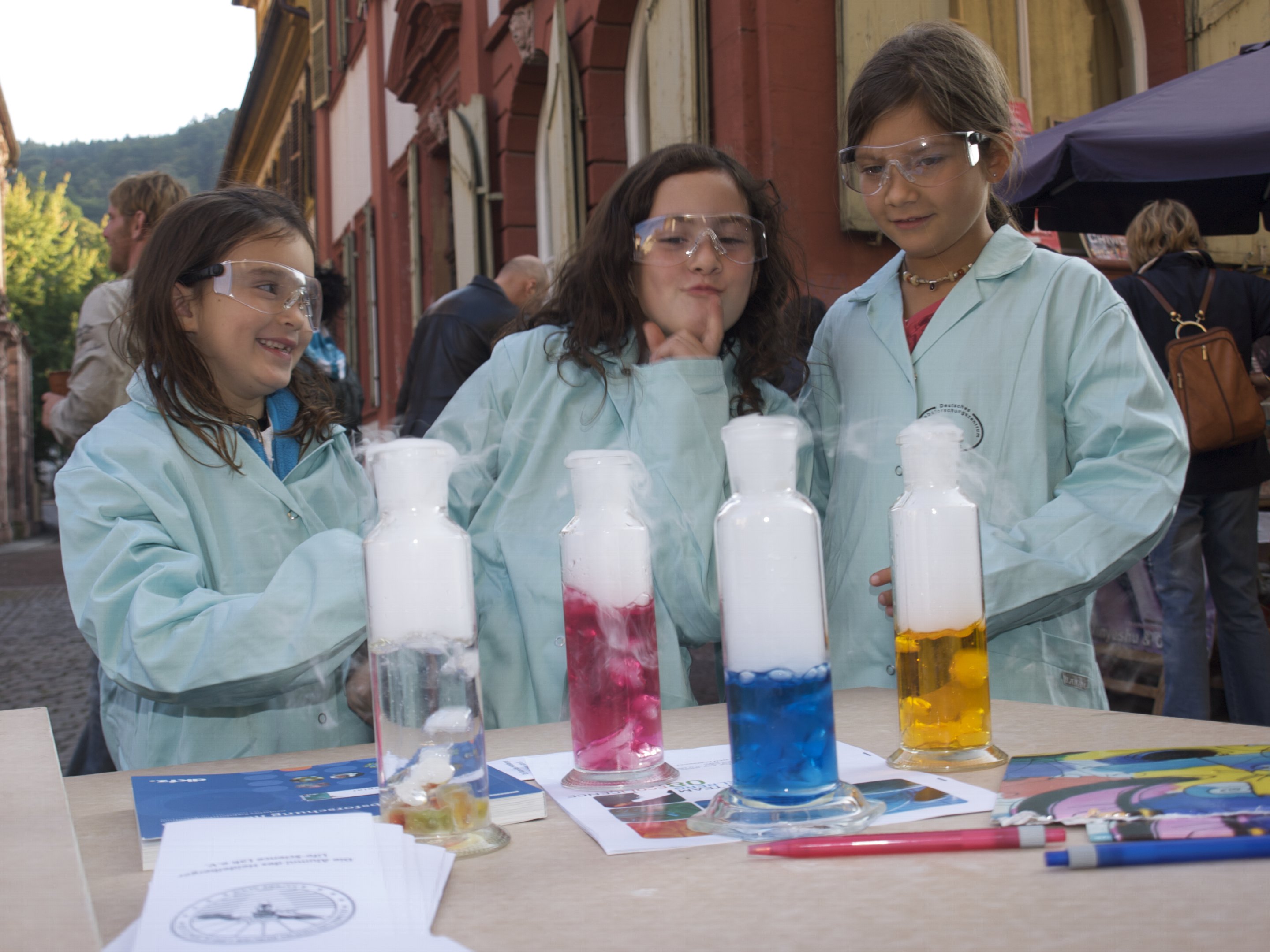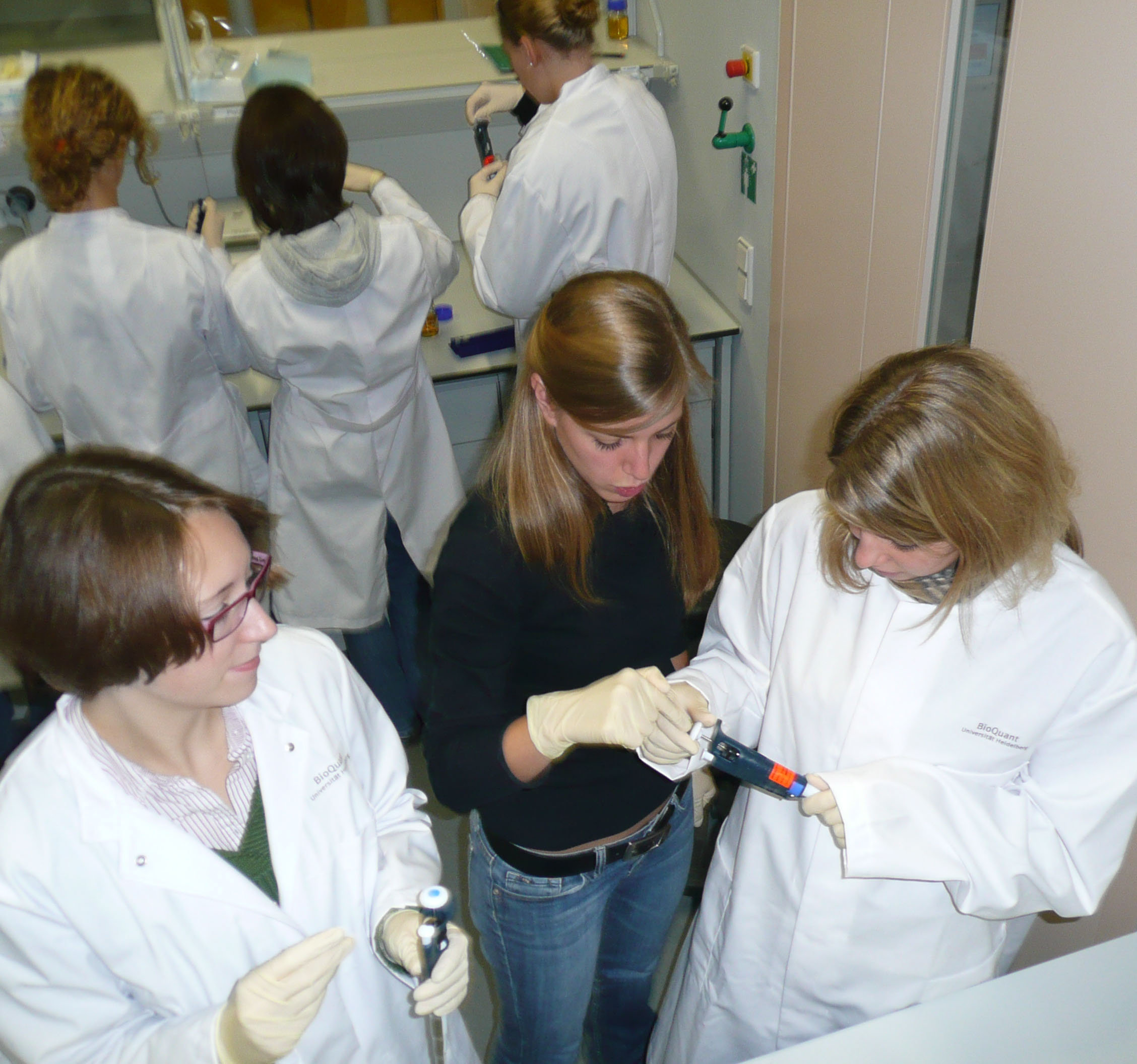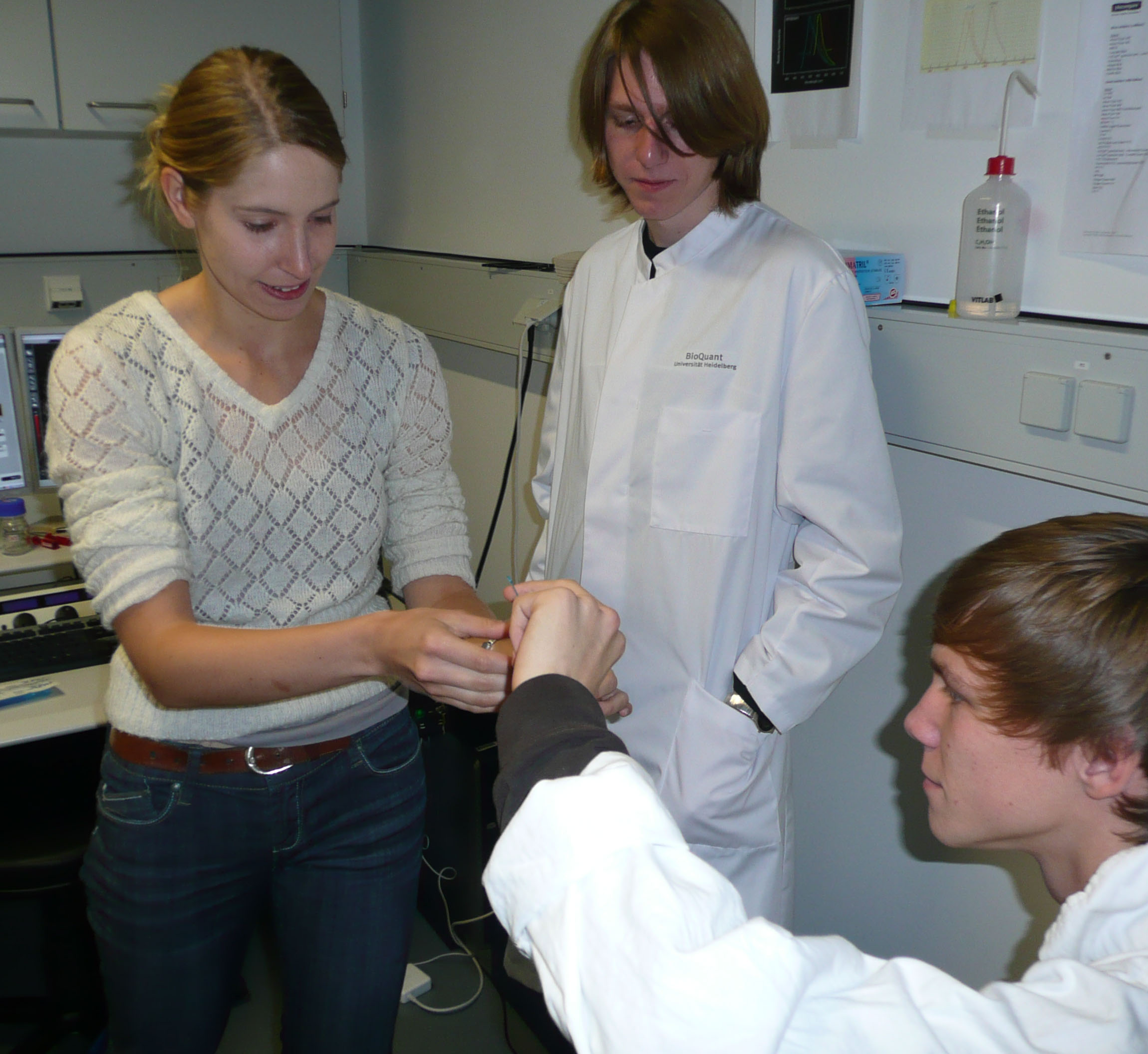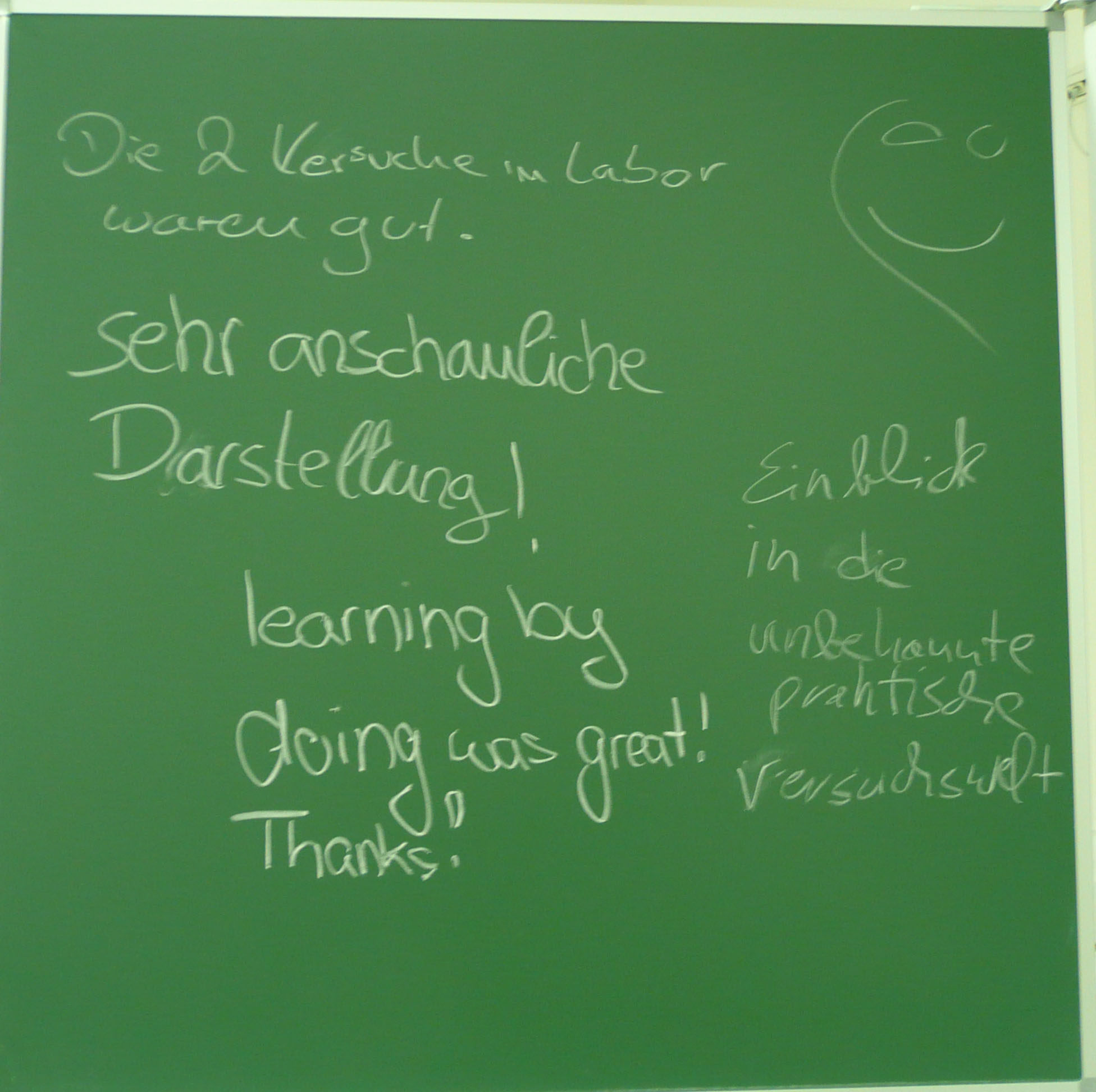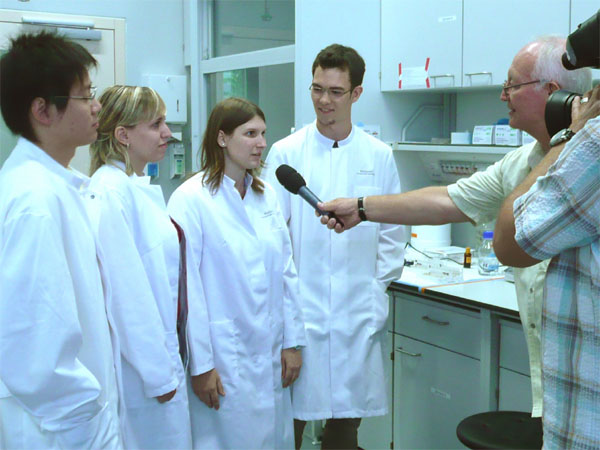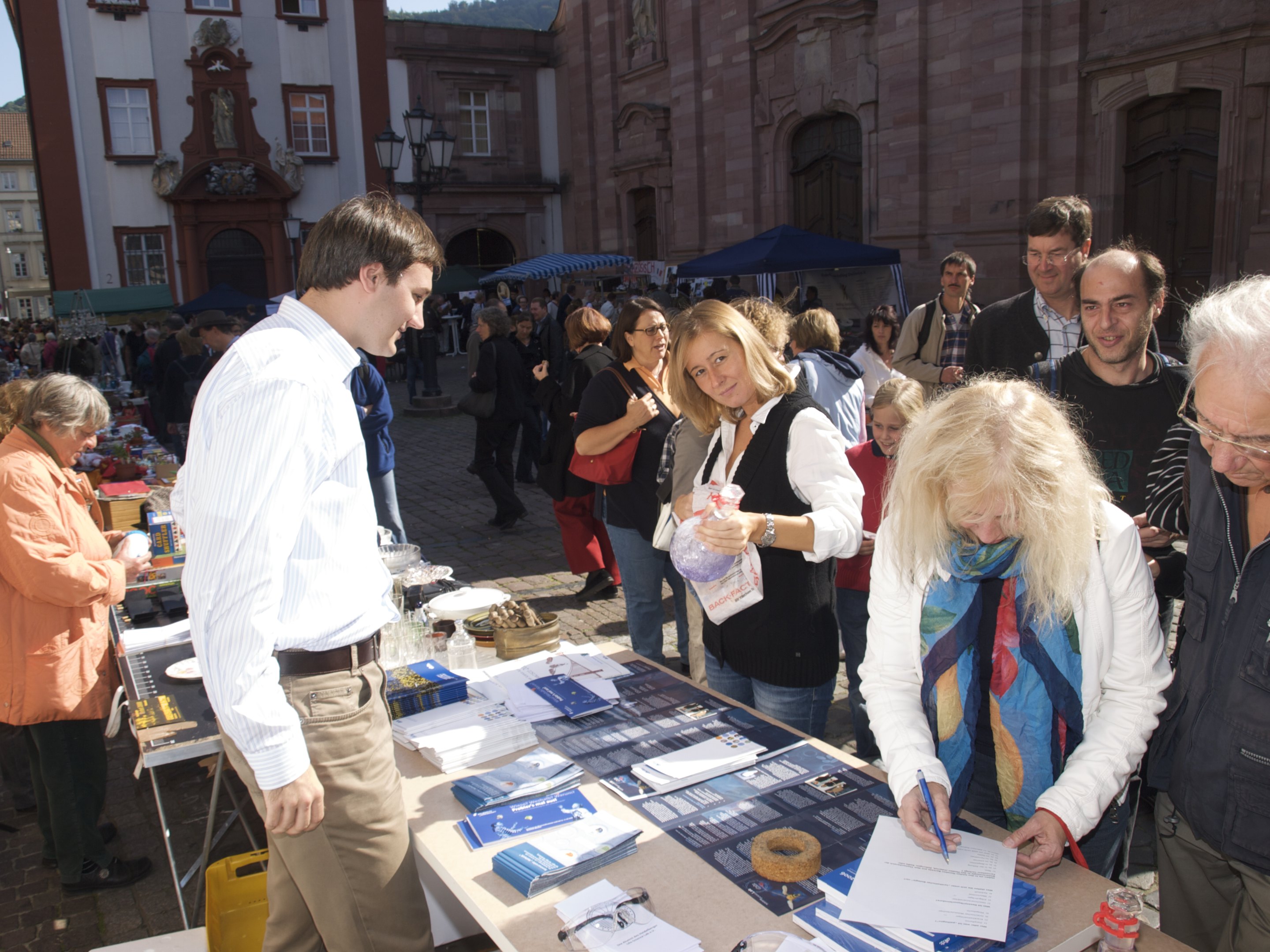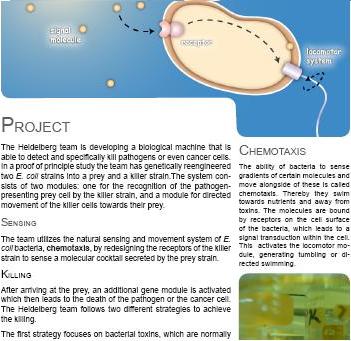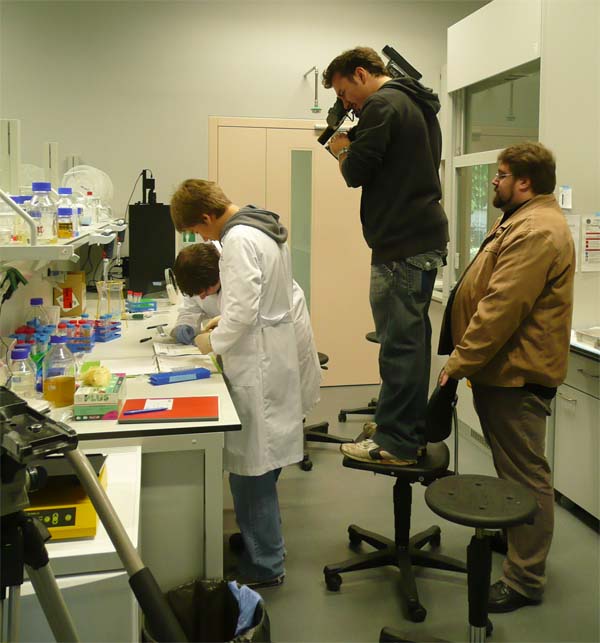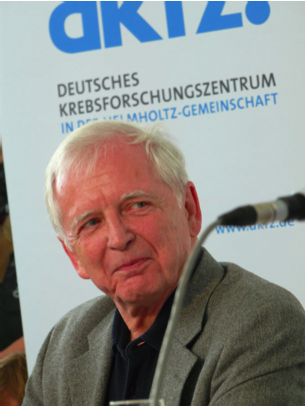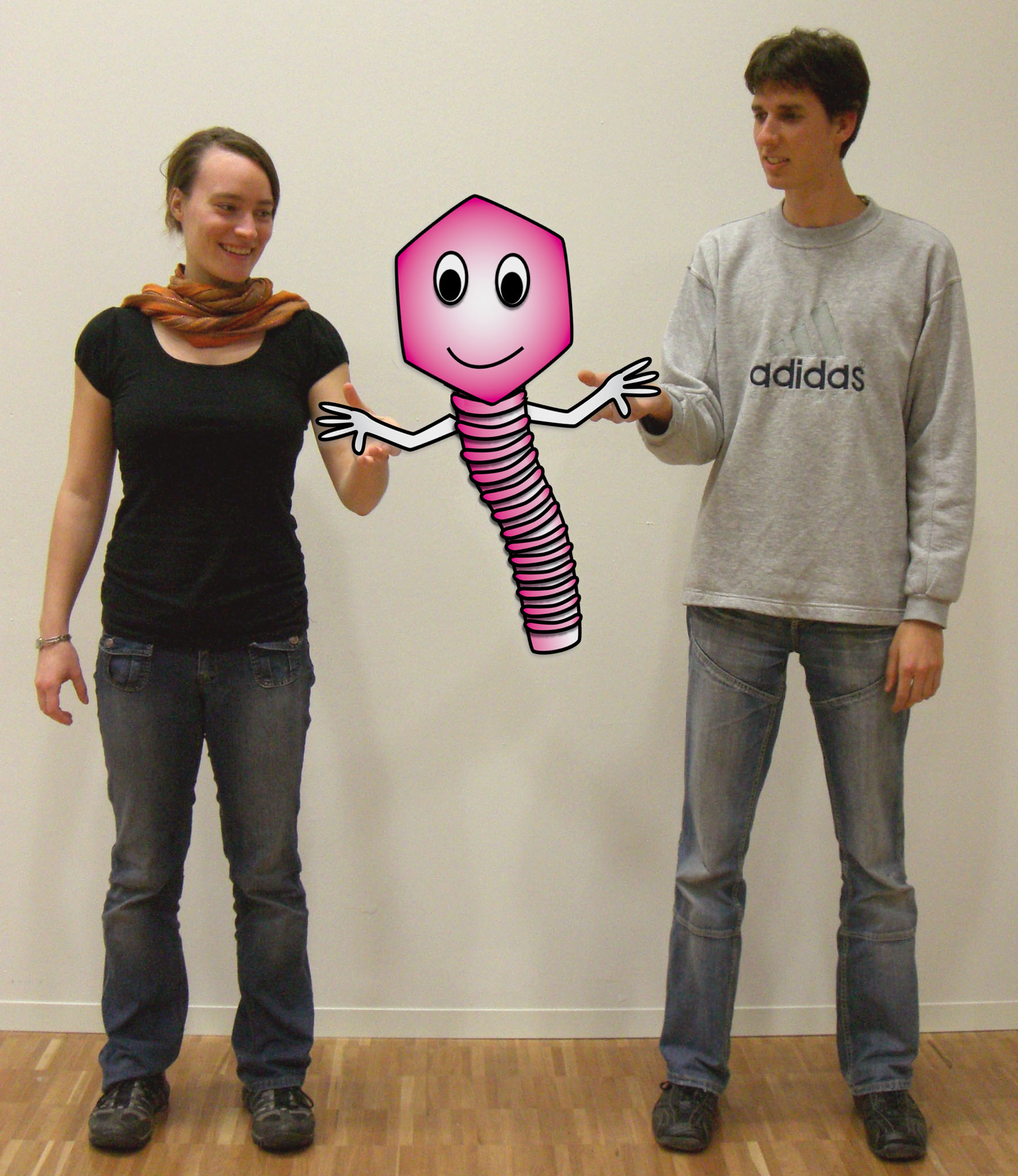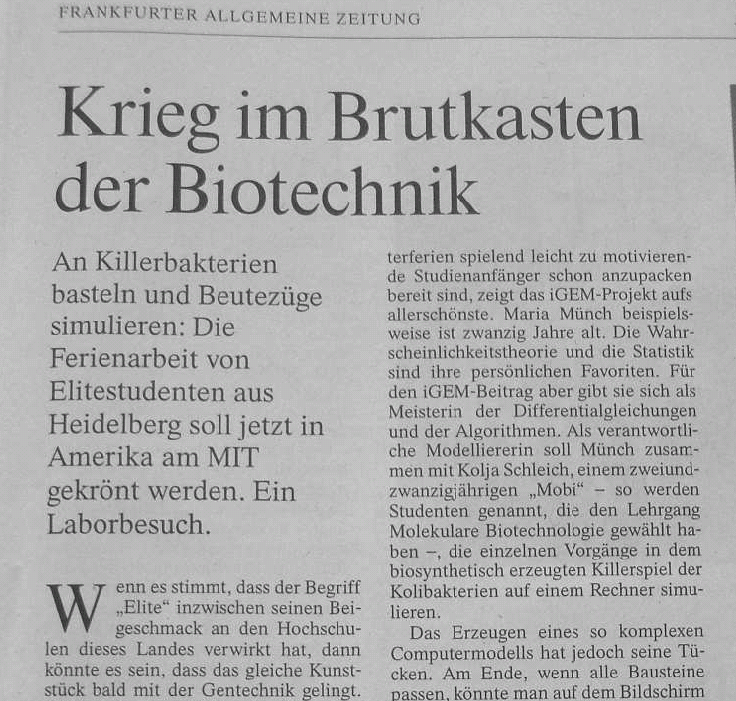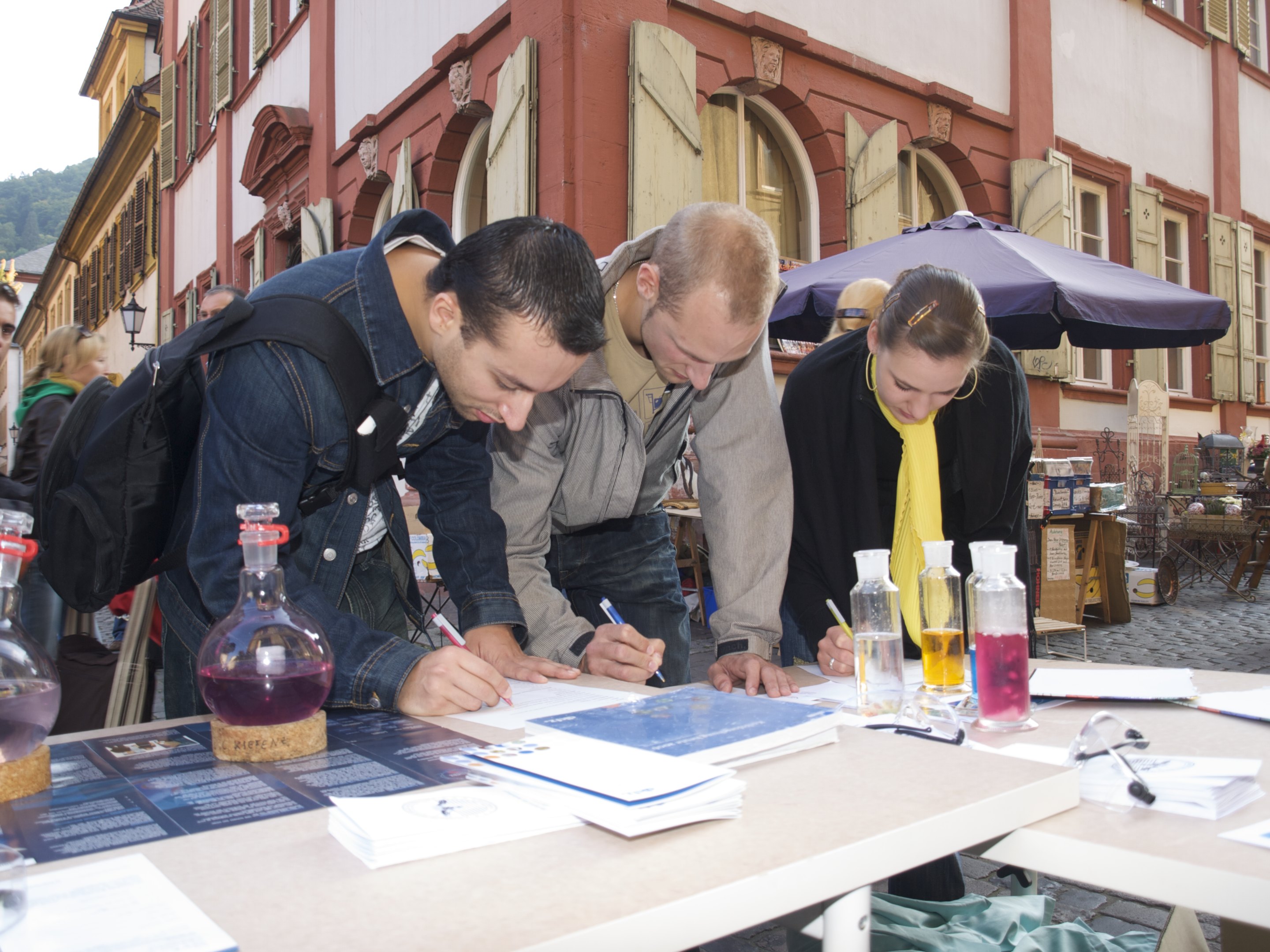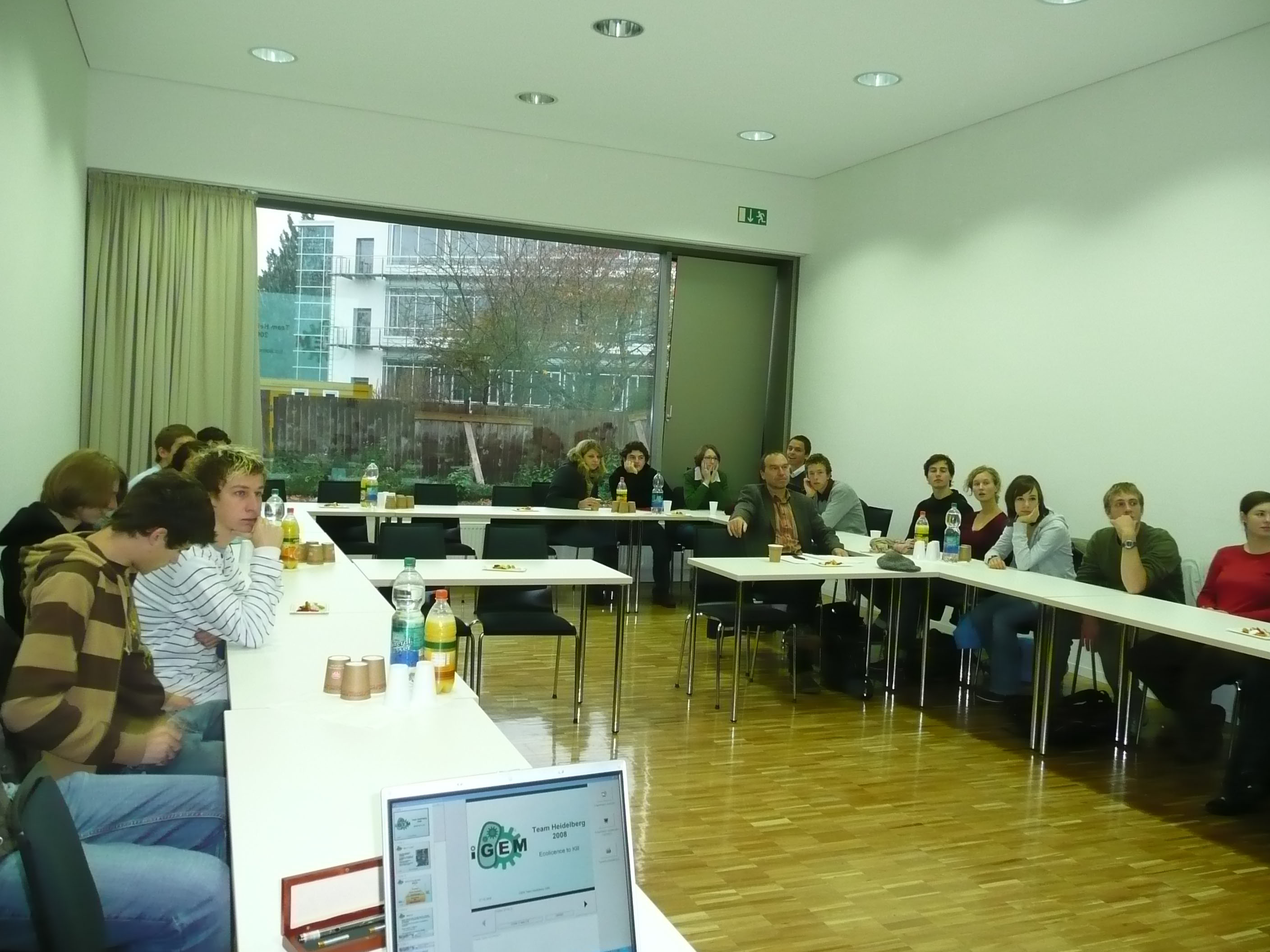Team:Heidelberg/Human Practice/Project Overview
From 2008.igem.org
(→Surveys) |
Annastoeckl (Talk | contribs) (→The Phips the Phage Portal) |
||
| (140 intermediate revisions not shown) | |||
| Line 1: | Line 1: | ||
__NOTOC__ | __NOTOC__ | ||
<html> | <html> | ||
| - | <link | + | |
| - | + | ||
| - | + | <style> | |
| + | h1.firstHeading { display: none; } | ||
| + | |||
| + | p {text-align: justify;} | ||
| + | |||
| + | a:link { color: #00b0e6; text-decoration: none} | ||
| + | a:visited { color:#00b0e6; text-decoration: none} | ||
| + | a:hover { color:#f29400; text-decoration: none} | ||
| + | a:active { color:#f29400; text-decoration: none} | ||
| + | |||
| + | #bodyContent { padding: 10px auto; width: 910px; margin: auto; clear: none; } | ||
| + | |||
| + | table#team_members { text-align: justify; border: 0; } | ||
| + | table#team_members h2, table#team_members h3 { clear: both; } | ||
| + | |||
| + | |||
| + | /*-----------------------------------------------------------------------------------------------*/ | ||
| + | div.MenuBar ul li ul.DropDownMenu { | ||
| + | display: none; /* Hides all drop-down menus. */ | ||
| + | |||
| + | } | ||
| + | /* | ||
| + | li:hover works in IE7 and FF2. | ||
| + | a:hover works in IE6 and FF2. | ||
| + | a:hover breaks li:hover in FF2. | ||
| + | */ | ||
| + | div.MenuBar ul li:hover ul.DropDownMenu li ul.SideMenu, | ||
| + | div.MenuBar ul li a:hover ul.DropDownMenu li a ul.SideMenu { | ||
| + | display: none; /* Hides all side menus. */ | ||
| + | } | ||
| + | /*------------------------------------------------------------------------------------- Menu Bar */ | ||
| + | div.MenuBar { | ||
| + | font: arial, helvetica, sans-serif; | ||
| + | height: 30px; | ||
| + | width: 910px; | ||
| + | /*width: 100%*/ | ||
| + | margin: 0; | ||
| + | border-top: 0; | ||
| + | border-right: 0; | ||
| + | border-left: 0; | ||
| + | padding: 0; | ||
| + | background: black; | ||
| + | |||
| + | } | ||
| + | div.MenuBar ul { | ||
| + | font: arial, helvetica, sans-serif; | ||
| + | text-align: center; | ||
| + | list-style-type: none; | ||
| + | margin: 0.5em auto; | ||
| + | border: 0; | ||
| + | padding: 0; | ||
| + | background: black; | ||
| + | } | ||
| + | div.MenuBar ul li { | ||
| + | font: arial, helvetica, sans-serif; | ||
| + | display: block; | ||
| + | padding: 0; | ||
| + | margin: 0; | ||
| + | font-size: 1.3em; | ||
| + | float: left; | ||
| + | background: black; | ||
| + | text-align: center; | ||
| + | width: 107px; | ||
| + | position: relative; /* Sets the positioning context for each drop-down menu. */ | ||
| + | } | ||
| + | |||
| + | div.MenuBar ul li a { | ||
| + | font: arial, helvetica, sans-serif; | ||
| + | display: block; | ||
| + | background: black; | ||
| + | height: 22px; /* Keep height + padding-top + padding-bottom sync with the menu bar height. */ | ||
| + | color: #ffffff; | ||
| + | padding-top: 4px; | ||
| + | padding-bottom: 4px; | ||
| + | padding-left: 1em; /* Sets the left space between top-level items. */ | ||
| + | padding-right: 1em; /* Sets the right space between top-level items. */ | ||
| + | text-decoration: none; | ||
| + | } | ||
| + | |||
| + | /*------------------------------------------------------------------------------ Drop-Down Menus */ | ||
| + | div.MenuBar ul li:hover ul.DropDownMenu, | ||
| + | div.MenuBar ul li a:hover ul.DropDownMenu { | ||
| + | display: block; | ||
| + | width: 10em; /* Drop-down menu width. | ||
| + | Use MenuTailor.css to customize. */ | ||
| + | height: 1em; | ||
| + | padding: 1px; /* Sets the drop-down menu "effective border" width. */ | ||
| + | position: absolute; | ||
| + | top: 23px; /* Places the drop-down menu under the menu bar. | ||
| + | Keep it sync with the menu bar height. */ | ||
| + | left: 0; /* Aligns the drop-down menu to its top-level item. */ | ||
| + | background-color: black; /* Selected item. */ | ||
| + | color: #FFFFFF; | ||
| + | |||
| + | } | ||
| + | div.MenuBar ul li:hover ul.DropDownMenu li a, | ||
| + | div.MenuBar ul li a:hover ul.DropDownMenu li a { | ||
| + | width: 10em; /* Keep it sync with the drop-down menu width. | ||
| + | Use MenuTailor.css to customize. */ | ||
| + | height: 1em; | ||
| + | padding-left: 0; | ||
| + | padding-right: 0; | ||
| + | background-color: black; /* Selected item. */ | ||
| + | color: #FFFFFF; | ||
| + | } | ||
| + | ul.DropDownMenu li a span { | ||
| + | display: block; | ||
| + | padding-left: 0.75em; /* Sets the left space of each drop-down menu item. */ | ||
| + | padding-right: 0.25em; /* Sets the right space of each drop-down menu item. */ | ||
| + | text-align: right; /* Aligns the >> symbol to the right. */ | ||
| + | } | ||
| + | ul.DropDownMenu li a span span { | ||
| + | float: left; /* Aligns the text (back) to the left. */ | ||
| + | font: 12px arial, helvetica, sans-serif; /* Required for IE55. */ | ||
| + | height: 20px; | ||
| + | color: #FFFFFF; | ||
| + | } | ||
| + | /*----------------------------------------------------------------------------------- Side Menus */ | ||
| + | div.MenuBar ul li:hover ul.DropDownMenu li:hover ul.SideMenu, | ||
| + | div.MenuBar ul li a:hover ul.DropDownMenu li a:hover ul.SideMenu { | ||
| + | display: block; | ||
| + | width: 11em; /* Side menu width. | ||
| + | Use MenuTailor.css to customize. */ | ||
| + | padding: 1px; /* Sets the side menu "effective border" width. */ | ||
| + | position: absolute; | ||
| + | top: -1px; /* Aligns the side menu to its drop-down menu item. | ||
| + | Keep it sync with the side menu "effective border" width. */ | ||
| + | left: 13em; /* Places the side menu to the right of the drop-down menu. | ||
| + | Keep it sync with the drop-down menu width. | ||
| + | Use MenuTailor.css to customize. */ | ||
| + | } | ||
| + | div.MenuBar ul li:hover ul.DropDownMenu li:hover ul.SideMenu li a, | ||
| + | div.MenuBar ul li a:hover ul.DropDownMenu li a:hover ul.SideMenu li a { | ||
| + | width: 11em; /* Keep it sync with the side menu width. | ||
| + | Use MenuTailor.css to customize. */ | ||
| + | font: 12px arial, helvetica, sans-serif; /* Required for IE55. */ | ||
| + | left: 13em; /* Places the side menu to the right of the drop-down menu. | ||
| + | Keep it sync with the drop-down menu width. | ||
| + | Use MenuTailor.css to customize. */ | ||
| + | } | ||
| + | div.MenuBar ul li ul.DropDownMenu li ul.SideMenu li a span { | ||
| + | padding-left: 1.5em; /* Sets the left space of each side menu item. */ | ||
| + | padding-right: 0.5em; /* Sets the right space of each side menu item. */ | ||
| + | text-align: left; | ||
| + | font: 12px arial, helvetica, sans-serif; /* Required for IE55. */ | ||
| + | left: 13em; /* Places the side menu to the right of the drop-down menu. | ||
| + | Keep it sync with the drop-down menu width. | ||
| + | Use MenuTailor.css to customize. */ | ||
| + | } | ||
| + | /*----------------------------------------------------------------------------- Browser Specific */ | ||
| + | * html div.MenuBar ul li a { | ||
| + | float: left; /* Required for IE55 and IE6. | ||
| + | Breaks O9. | ||
| + | Hidden (* html) from non-IE browsers. */ | ||
| + | } | ||
| + | * html ul.DropDownMenu li a:hover { | ||
| + | cursor: hand; /* Required for IE55. | ||
| + | Hidden (* html) from non-IE browsers. */ | ||
| + | } | ||
| + | ul.DropDownMenu li a:hover { | ||
| + | cursor: pointer; /* Required for IE6 and IE7. | ||
| + | Hidding it (* html) from non-IE browsers breaks IE7! | ||
| + | } | ||
| + | * html div.MenuBar a:hover { | ||
| + | text-decoration: none; /* Required for IE55 and IE6. | ||
| + | Hidden (* html) from non-IE browsers. */ | ||
| + | } | ||
| + | * html div.MenuBar ul li table, | ||
| + | * html div.MenuBar ul li table td { | ||
| + | border: 0; /* Required for IE55 and IE6. | ||
| + | Hidden (* html) from non-IE browsers. */ | ||
| + | } | ||
| + | /*------------------------------------------------------------------------------- Default Colors */ | ||
| + | div.MenuBar { | ||
| + | background-color: Menu; | ||
| + | border-bottom: 1px solid ButtonShadow; | ||
| + | } | ||
| + | div.MenuBar a { | ||
| + | background-color: Menu; /* Top-level unselected items. */ | ||
| + | color: MenuText; | ||
| + | } | ||
| + | div.MenuBar ul li:hover a, | ||
| + | div.MenuBar ul li a:hover { | ||
| + | color: #ea7f16; | ||
| + | background-color: Highlight; /* Top-level selected item. */ | ||
| + | color: HighlightText; | ||
| + | } | ||
| + | /*...............................................................................................*/ | ||
| + | div.MenuBar ul li:hover ul.DropDownMenu, | ||
| + | div.MenuBar ul li a:hover ul.DropDownMenu { | ||
| + | background-color: ButtonShadow; /* Sets the drop-down menu "effective border" color. */ | ||
| + | } | ||
| + | div.MenuBar ul li:hover ul.DropDownMenu li a, | ||
| + | div.MenuBar ul li a:hover ul.DropDownMenu li a { | ||
| + | background-color: Menu; Drop-down menu unselected items. | ||
| + | Sets the drop-down menu "effective background" color. */ | ||
| + | color: MenuText; | ||
| + | } | ||
| + | div.MenuBar ul li:hover ul.DropDownMenu li:hover a, | ||
| + | div.MenuBar ul li a:hover ul.DropDownMenu li a:hover { | ||
| + | background-color: Highlight; /* Drop-down menu selected item. */ | ||
| + | color: HighlightText; | ||
| + | } | ||
| + | /*...............................................................................................*/ | ||
| + | div.MenuBar ul li:hover ul.DropDownMenu li:hover ul.SideMenu, | ||
| + | div.MenuBar ul li a:hover ul.DropDownMenu li a:hover ul.SideMenu { | ||
| + | background-color: ButtonShadow; /* Sets the side menu "effective border" color. */ | ||
| + | } | ||
| + | div.MenuBar ul li:hover ul.DropDownMenu li:hover ul.SideMenu li a, | ||
| + | div.MenuBar ul li a:hover ul.DropDownMenu li a:hover ul.SideMenu li a { | ||
| + | background-color: Menu; /* Side menu unselected items. | ||
| + | Sets the side menu "effective background" color. */ | ||
| + | color: MenuText; | ||
| + | } | ||
| + | div.MenuBar ul li:hover ul.DropDownMenu li:hover ul.SideMenu li a:hover, | ||
| + | div.MenuBar ul li a:hover ul.DropDownMenu li a:hover ul.SideMenu li a:hover { | ||
| + | background-color: Highlight; /* Side menu selected item. */ | ||
| + | color: HighlightText; | ||
| + | } | ||
| + | /*-----------------------------------------------------------------------------------------------*/ | ||
| + | /*Script-Free 3-Level Menu 1.2 Tailor | ||
| + | www.CesarDaniel.info | ||
| + | /*-------------------------------------------------------------------------------------- General */ | ||
| + | body { | ||
| + | background: white; | ||
| + | color: black; | ||
| + | margin: 0; | ||
| + | border: 0; | ||
| + | padding: 0; | ||
| + | } | ||
| + | |||
| + | |||
| + | div.MenuBar { | ||
| + | font: 13px arial, helvetica, sans-serif; | ||
| + | } | ||
| + | div.MenuBar ul { | ||
| + | font: 13px arial, helvetica, sans-serif; /* Required for IE55. */ | ||
| + | } | ||
| + | /*--------------------------------------------------------------------------------------- Colors */ | ||
| + | div.MenuBar { | ||
| + | background-color: black; /* Selected item. */ | ||
| + | color: #FFFFFF; | ||
| + | border-bottom: 1px solid ButtonShadow; | ||
| + | } | ||
| + | div.MenuBar a, | ||
| + | div.MenuBar ul li:hover ul.DropDownMenu li a, | ||
| + | div.MenuBar ul li a:hover ul.DropDownMenu li a, | ||
| + | div.MenuBar ul li:hover ul.DropDownMenu li:hover ul.SideMenu li a, | ||
| + | div.MenuBar ul li a:hover ul.DropDownMenu li a:hover ul.SideMenu li a { | ||
| + | background-color: black; /* Selected item. */ | ||
| + | color: #FFFFFF; | ||
| + | } | ||
| + | div.MenuBar ul li:hover a, | ||
| + | div.MenuBar ul li a:hover, | ||
| + | div.MenuBar ul li:hover ul.DropDownMenu li:hover a, | ||
| + | div.MenuBar ul li a:hover ul.DropDownMenu li a:hover, | ||
| + | div.MenuBar ul li:hover ul.DropDownMenu li:hover ul.SideMenu li a:hover, | ||
| + | div.MenuBar ul li a:hover ul.DropDownMenu li a:hover ul.SideMenu li a:hover { | ||
| + | background-color: #00b0e6; /* Selected item. */ | ||
| + | color: #FFFFFF; | ||
| + | } | ||
| + | div.MenuBar ul li:hover ul.DropDownMenu, | ||
| + | div.MenuBar ul li a:hover ul.DropDownMenu, | ||
| + | div.MenuBar ul li:hover ul.DropDownMenu li:hover ul.SideMenu, | ||
| + | div.MenuBar ul li a:hover ul.DropDownMenu li a:hover ul.SideMenu { | ||
| + | background-color: ButtonShadow; /* Sets the drop-down and side menus "effective border" color. */ | ||
| + | } | ||
| + | /*--------------------------------------------------------------------------------------- Widths */ | ||
| + | /* | ||
| + | |||
| + | /* | ||
| + | Menu Bar 1 | ||
| + | Drop-Down Menu #2 | ||
| + | */ | ||
| + | div.MenuBar#navi ul li:hover ul.DropDownMenu#MB1-DDM4, | ||
| + | div.MenuBar#navi ul li a:hover ul.DropDownMenu#MB1-DDM4, | ||
| + | div.MenuBar#navi ul li:hover ul.DropDownMenu#MB1-DDM4 li a, | ||
| + | div.MenuBar#navi ul li a:hover ul.DropDownMenu#MB1-DDM4 li a { | ||
| + | width: 11em; /* Drop-down menu width. */ | ||
| + | } | ||
| + | div.MenuBar#navi ul li:hover ul.DropDownMenu#MB1-DDM5, | ||
| + | div.MenuBar#navi ul li a:hover ul.DropDownMenu#MB1-DDM5, | ||
| + | div.MenuBar#navi ul li:hover ul.DropDownMenu#MB1-DDM5 li a, | ||
| + | div.MenuBar#navi ul li a:hover ul.DropDownMenu#MB1-DDM5 li a { | ||
| + | width: 12em; /* Drop-down menu width. */ | ||
| + | } | ||
| + | |||
| + | /*...............................................................................................*/ | ||
| + | /* | ||
| + | Menu Bar 1 | ||
| + | Drop-Down Menu #2 | ||
| + | Side Menu #1 | ||
| + | */ | ||
| + | div.MenuBar#navi ul li:hover ul.DropDownMenu li:hover ul.SideMenu#MB1-DDM2-SM1, | ||
| + | div.MenuBar#navi ul li a:hover ul.DropDownMenu li a:hover ul.SideMenu#MB1-DDM2-SM1 { | ||
| + | left: 15.5em !important; /* Places the side menu to the right of the drop-down menu. | ||
| + | Keep it sync with the drop-down menu width. */ | ||
| + | } | ||
| + | div.MenuBar#navi ul li:hover ul.DropDownMenu li:hover ul.SideMenu#MB1-DDM2-SM1, | ||
| + | div.MenuBar#navi ul li a:hover ul.DropDownMenu li a:hover ul.SideMenu#MB1-DDM2-SM1, | ||
| + | div.MenuBar#navi ul li:hover ul.DropDownMenu li:hover ul.SideMenu#MB1-DDM2-SM1 li a, | ||
| + | div.MenuBar#navi ul li a:hover ul.DropDownMenu li a:hover ul.SideMenu#MB1-DDM2-SM1 li a { | ||
| + | width: 10em; /* Side menu width. */ | ||
| + | } | ||
| + | /*...............................................................................................*/ | ||
| + | /* | ||
| + | Menu Bar 1 | ||
| + | Drop-Down Menu #2 | ||
| + | Side Menu #2 | ||
| + | */ | ||
| + | div.MenuBar#navi ul li:hover ul.DropDownMenu li:hover ul.SideMenu#MB1-DDM2-SM2, | ||
| + | div.MenuBar#navi ul li a:hover ul.DropDownMenu li a:hover ul.SideMenu#MB1-DDM2-SM2 { | ||
| + | left: 15.5em !important; /* Places the side menu to the right of the drop-down menu. | ||
| + | Keep it sync with the drop-down menu width. */ | ||
| + | } | ||
| + | div.MenuBar#navi ul li:hover ul.DropDownMenu li:hover ul.SideMenu#MB1-DDM2-SM2, | ||
| + | div.MenuBar#navi ul li a:hover ul.DropDownMenu li a:hover ul.SideMenu#MB1-DDM2-SM2, | ||
| + | div.MenuBar#navi ul li:hover ul.DropDownMenu li:hover ul.SideMenu#MB1-DDM2-SM2 li a, | ||
| + | div.MenuBar#navi ul li a:hover ul.DropDownMenu li a:hover ul.SideMenu#MB1-DDM2-SM2 li a { | ||
| + | width: 10em; /* Side menu width. */ | ||
| + | } | ||
| + | /*...............................................................................................*/ | ||
| + | /* | ||
| + | Menu Bar 1 | ||
| + | Drop-Down Menu #2 | ||
| + | Side Menu #3 | ||
| + | */ | ||
| + | div.MenuBar#navi ul li:hover ul.DropDownMenu li:hover ul.SideMenu#MB1-DDM2-SM3, | ||
| + | div.MenuBar#navi ul li a:hover ul.DropDownMenu li a:hover ul.SideMenu#MB1-DDM2-SM3 { | ||
| + | left: 15.5em !important; /* Places the side menu to the right of the drop-down menu. | ||
| + | Keep it sync with the drop-down menu width. */ | ||
| + | } | ||
| + | div.MenuBar#navi ul li:hover ul.DropDownMenu li:hover ul.SideMenu#MB1-DDM2-SM3, | ||
| + | div.MenuBar#navi ul li a:hover ul.DropDownMenu li a:hover ul.SideMenu#MB1-DDM2-SM3, | ||
| + | div.MenuBar#navi ul li:hover ul.DropDownMenu li:hover ul.SideMenu#MB1-DDM2-SM3 li a, | ||
| + | div.MenuBar#navi ul li a:hover ul.DropDownMenu li a:hover ul.SideMenu#MB1-DDM2-SM3 li a { | ||
| + | width: 10em; /* Side menu width. */ | ||
| + | } | ||
| + | /*...............................................................................................*/ | ||
| + | |||
| + | </style> | ||
| + | |||
<body> | <body> | ||
| Line 122: | Line 463: | ||
</body> | </body> | ||
</html> | </html> | ||
| + | |||
| + | {|id="team_members" | ||
| + | |-valign="top" | ||
| + | |width="650px" style="padding: 0 20px 0 0;"| | ||
== '''Human Practice - Science Communication''' == | == '''Human Practice - Science Communication''' == | ||
| - | |||
| - | + | == '''The Team''' == | |
| - | ''' | + | |
| - | + | This project was set up mainly by two students of the Heidelberg iGEM team, who felt the need to communicate the work of the iGEM team in the context of synthetic biology. Additionally to the wet lab work for the main project, they put all their remaining time and ressources into the buildup of this science communication platform. This fact already reflects one major challenge of the Human Practice Project Heidelberg: Abrogating the separation between scientific work and science communication. The science communication team was highly supported by the advisor Jan Eufinger. And last but not least there have to be mentioned all the members of our iGEM team, who supported this project with ideas and help and without whom we would never have been able to carry out events like the public survey and the Open Day. | |
| - | + | ||
| - | + | ||
| - | + | == '''The Idea''' == | |
| - | ''''' | + | |
| - | + | Synthetic Biology is a very young and dynamic scientific field. And as most modern scientific fields, synthetic biology offers many chances in solving actual problems. But on the other hand- and we want to communicate that quite clearly here- synthetic biology also comprises risks. The same risks that every modern science entains. Profound and detailed analyses of the ethical aspects concerning synthetic biology can be found on the following pages of other iGEM teams ([https://2008.igem.org/Team:TUDelft/Ethics_introduction TUDelft], [https://2008.igem.org/Team:Calgary_Ethics Calgary], [https://2008.igem.org/Team:KULeuven/Ethics/Introduction KULeuven]). In our opinion, there is an important step before ethical considerations of synthetic biology can be made by the public or by policy makers: They first have to know about synthetic biology, have to understand this new research area and therefore have to understand the basics of molecular and cell biology. And this step is where our project is involved.<br/> <br/> | |
| - | The | + | |
| - | <br/> | + | |
| - | == '''The Essay''' == | + | '''"Only a well-informed public is able to develop a non-prejudiced and profound opinion about synthetic biology."'''<br/> <br/> |
| - | At first we | + | |
| + | From the past we learned, that modern bioscience is not always accepted and fully integrated in the public interest. A good examle is the public view on green biotechnolgy in Germany and Europe. Many people in Germany are afraid of eating genetically manipulated food, although most do not even know the difference between genetically manipulated food and ''normal'' food. And a real problem arises when nescience about the scientific backround is added to this scepsis. The combination of nescience and scepsis is the sward of Damocles of every new, upcoming scientific field, such as green biotechnology once was, because this combination in many cases leads to fear and by that to non-acceptance in the society. And this is what green biotechnology has to battle every single day. <br/><br/> | ||
| + | |||
| + | '''"Science can only work successful and develop useful inventions if it is based on a high level of acceptance in the society."'''<br/> <br/> | ||
| + | Synthetic biology is up to now very young and far away from experiencing the same problematic lack of acceptance that genetic engineering and green biotechnology underwent in many European countries. But there is a risk that the public becomes sceptical towards the uprising star in the fields of lifesciences. And that could lead to unsubstantial prejudices and by that to non-acceptance of the modern synthetic biology research area. <br/> <br/> | ||
| + | |||
| + | A non-acceptance of synthetic biology by the public could lead to a retarding of the advance of synthetic biology and possibly to the non-development of many useful inventions. | ||
| + | Our project is organized around the idea that only a well-informed public is able to develop a non-prejudiced and profound opinion about synthetic biology, which will be the basis for a healthy development of the relations between science and public. Therefore we worked on the following levels: <br/> | ||
| + | |||
| + | [[https://2008.igem.org/Team:Heidelberg/Human_Practice/Project_Overview back]] | ||
| + | |||
| + | == '''[https://2008.igem.org/Team:Heidelberg/Human_Practice/Essay The Essay]''' == | ||
| + | At first we developed a concept, how we wanted to enable a good, non-frightening, but honest and informing way of science communication. Read the Essay [https://2008.igem.org/Team:Heidelberg/Human_Practice/Essay '''here'''] | ||
<br/> | <br/> | ||
| + | [[https://2008.igem.org/Team:Heidelberg/Human_Practice/Project_Overview back]] | ||
| - | == '''Surveys''' == | + | == '''[[Team:Heidelberg/Human_Practice/Surveys|The Surveys]]''' == |
| - | Second we | + | Second, we carried out an information and survey day to investigate the opinion of non-scientists on science communication and synthetic biology- so that we would know where the weaknesses in science communication are. Therefore we surveyed about 100 people from different intellectual and cultural backrounds in the Heidelberg pedestrian area. To determine the opinion of scientist on science communication we surveyed in addition about 300 scientists (PhD students, post docs and professors) at the BioQuant and the German Cancer Research Center. That gave us the starting point of our practical work. <br/> |
| + | |||
| + | Here you can find additional information and the evaluation of the [https://2008.igem.org/Team:Heidelberg/Human_Practice/Surveys#Survey-Public '''public survey'''] and the evaluation of the [https://2008.igem.org/Team:Heidelberg/Human_Practice/Surveys#Survey-Scientists '''scientist- survey''']. | ||
| + | |||
| + | == '''[[Team:Heidelberg/Human_Practice/Nobel_Prize| The Nobel Prize]]''' == | ||
| + | |||
| + | We also had the great opportunity to get to know the opinion of a Nobel Prize winner about science communication. This year's Nobel prize winner in Medicine, Prof. zur Hausen, kindly gave us an interview on this topic! Read the interview [[Team:Heidelberg/Human_Practice/Nobel_Prize| '''here''']] | ||
<br/> | <br/> | ||
| + | [[https://2008.igem.org/Team:Heidelberg/Human_Practice/Project_Overview back]] | ||
| + | |||
| + | == '''Information, Honesty and close Contact to the public''' == | ||
| + | |||
| + | Third, and that was the most important part of the project, we wanted to practice a way of science communication based on our antecedent research and theoretical work, which would at the end lead to a close contact and a close exchange between our scientific work on the iGEM project and the public. The aim of this practical approach was to inform the public and by that prevent upcoming unsubstantional fear and scepsis and give to the public the knowledge necessary to built a substantional opinion on the upcoming field of synthetic biology. In our opinion the three bases of science communication are: <br/> <br/> | ||
| + | '''Information, Honesty and close Contact'''. <br/> <br/> | ||
| + | Thus we used different communication approaches to get a broad contact and to reach people from different intellectual and age-related backround. | ||
| + | The general idea of our approach- and therefore the decisive point of our human practices project- is to integrate our research into science communication and not only to communicate the results- which in our opinion would cause a seperation of our work from the public. Thus we wanted to give the public an insight into our wet lab work and also make it possible for non-scientists to follow the project description and documentation of our project. In the following we will give an overview on the practical approaches we used to reach this aim. | ||
| + | |||
| + | [[https://2008.igem.org/Team:Heidelberg/Human_Practice/Project_Overview back]] | ||
| + | |||
| + | == '''[[Team:Heidelberg/Press|Media Work]]''' == | ||
| + | |||
| + | We had a close collaboration with one of the most well-known newspapers in Germany: The Frankfurter Allgemeine Zeitung (FAZ). In addition we had close contact to the TV stations Campus-TV Heidelberg and Prometheus TV as well as good contact to the DKFZ institute press. Furthermore the radio station Ruperto Carola and the DKFZ, BioQuant and University Press-Devisions wrote articles concerning synthetic biology, our iGEM Team and the ongoing project work. Get an impression of our Media Work [[Team:Heidelberg/Press|'''here''']] | ||
| + | <br/> <br/> | ||
| + | Additionally, we made a brochure, telling about synthetic biology, iGEM and our wet lab project. These were distributed at schools and scientific meetings. It can be downloaded in english [[Media:IGEM_brochure.pdf| '''here''']] and in german [[Media:IGEM_Broschuere.pdf|'''here''']]. <br/> <br/> | ||
| + | Besides the contact to the press we tried to get into direct contact with people by performing the public survey and thereby informing on synthetic biology in a very personal and direct way. <br/> | ||
| + | |||
| + | [[https://2008.igem.org/Team:Heidelberg/Human_Practice/Project_Overview back]] | ||
| + | |||
| + | == '''[[Team:Heidelberg/Human_Practice/Open_Day|The Open Day]]''' == | ||
| + | |||
| + | Additionally, we organized an Open Day. We invited pupils from different schools and introduced them theoretically and practically in the world of biobricks and synthetic biology. You can find an instruction for an open day as well as a report on our open day. Get information and material of our open day [[Team:Heidelberg/Human_Practice/Open_Day| '''here''']] <br/> | ||
| + | |||
| + | [[https://2008.igem.org/Team:Heidelberg/Human_Practice/Project_Overview back]] | ||
| + | |||
| + | == '''[[Team:Heidelberg/Human_Practice/Phips_the_Phage|The Phips the Phage Portal]]''' == | ||
| + | |||
| + | Last, but not at all least, we constructed a portal on the wiki called [[Team:Heidelberg/Human_Practice/Phips_the_Phage| '''Phips the Phage''']]. Here we present our project and synthetic biology in general to interested people without a deep biological background-knowledge. The idea of this portal is to develop a virtual guide (Phips) who guides the public through our project and adds relevant information every time when necessary- so even pupils should be able to understand what we did during the summer. | ||
| + | |||
| + | '''With Phips the Phage, the iGEM wiki for the first time serves as a platform to provide background information on synthetic biology and not only the scientific details.''' The concept we follow with this approach is not very frequently practiced, you could call it risky, we prefer to call it bold: | ||
| + | |||
| + | '''We aim to integrate the information for non-scientists into the information for scientists''', because we do not want to seperate the public from our research - not even from the documentation of our research. But since we know that most of the scientific details will not be understood by non-scientists, we have to provide background information. We organized the arrangement of this information in a way so that somebody who is interested in reading our project descripton, but does not understand everything at first, can directly follow the links to the Phips the Phage page and can find the information he/she needs to understand most of the scientific part. So the optimal way of using our internet portal would be from scientific information to background information and back to scientific information again - now with the chance to really understand the documentation of our project. It can not be mentioned enough: '''Only with a profound understanding somebody can build his/her own opinion.''' And this is what we want to enable interested non-scientists to do. Therefore, in our opinion, it is not enough to give some information clearly put together for non-scientists. Because as we said, we want to be honest. And one can get the best and purest impression of our scientific work in directly reading the documentation of it. Of course, everybody is free to pick the information he/she is interested in from what we provide - but at least we want to give everybody the chance to get as much and as pure and honest information as possible. | ||
| + | [[https://2008.igem.org/Team:Heidelberg/Human_Practice/Project_Overview back]] | ||
| + | |||
| + | '''The Phips the Phage Portal is divided into three sections''':<br> | ||
| + | - [[Team:Heidelberg/Human_Practice/Phips_the_Phage/General_Backround|'''... follow Phips to the general background information''']] <br> | ||
| + | - [[Team:Heidelberg/Human_Practice/Phips_the_Phage/Technical_Backround|'''... follow Phips to the tecnical background information''']] <br> | ||
| + | - [[Team:Heidelberg/Human_Practice/Phips_the_Phage/Project_Details|'''... follow Phips to the project details''']] <br> | ||
| + | <br> | ||
| + | '''See Phips and his friends sing the Ecolicence Song''' <br> | ||
| + | [[Team:Heidelberg/Ecolicence_Song| '''... follow Phips to the Ecolicence Song''']] | ||
| + | |||
| + | You can follow-up the '''Phips the Phage guiding tour''' [[Team:Heidelberg/Team#Team Heidelberg- Members|'''... follow Phips (step 1)''']][[Image:Phips_1.png|middle|50px]] | ||
| + | |||
| + | == '''Conclusions''' == | ||
| + | |||
| + | Considering our experience, we want to encourage every scientist - and this also means every participant of the iGEM competition - in popularizing their work. | ||
| + | We can assure you it is worth the effort! | ||
| + | |||
| + | First, it is not at all exhausting or boring to present science in a way so everybody can understand it. In fact, it is great fun. You can can invent little stories or look for fitting metaphers and thereby let your creative streak out. And you yourself will explore all the connections between the different parts of biological science anew, when you have to start your explanation at a very basic point and therefore go back to topics like bacterial life, restriction enzymes or viruses. | ||
| + | |||
| + | And the most important thing: The feedback you get is really positive. People are very interested in science - more than we thought when we startet the project - and our experience was that they acknowledge everybody who invests time to explain science to them in a way they can imagine and understand. '''The public wants to be integrated in science!''' | ||
| + | |||
| + | You can yourself contribute to the success of your science in communicating your work and thereby build healthy relations between science and public! The public will show their appreciation- by showing acceptance and understanding for your project and by that support your science. | ||
| + | |||
| + | |||
| + | ---- | ||
| + | |||
| + | We enriched our portal with many graphics explaining the content of the articles additionally. Unfortunately, there may be images, which cannot be viewed by all browsers. Mozilla Firefox 3.0 is able to show them all. [http://www.mozilla-europe.org/de/firefox/ Download Mozilla Firefox 3.0 here] | ||
| + | |||
| + | |width="250px"| | ||
| - | + | [[Image:surhd18.jpg|border|250 px|]] | |
| - | + | <br> <br> | |
| + | [[Image:Opd17.jpg|border|250px]] | ||
| + | <br> <br> | ||
| + | [[Image:Opd16.jpg|border|250 px|]] | ||
| + | <br> <br> | ||
| + | [[Image:Opd8.jpg|border|250 px|]] | ||
| + | <br> <br> | ||
| + | [[Image:interview_klein.jpg|border|250 px|]] | ||
| + | <br> <br> | ||
| + | [[Image:surhd10.jpg|border|250 px|]] | ||
| + | <br> <br> | ||
| + | [[Image:Broch_pic.JPG|border|250 px|]] | ||
| + | <br> <br> | ||
| + | [[Image:Prometheus.jpg|border|250 px|]] | ||
| + | <br> <br> | ||
| + | [[Image:zurhausen.png|border|250 px|]] | ||
| + | <br> <br> | ||
| + | [[Image:Phips_anna_domi.jpg|border|250 px]] | ||
| + | <br> <br> | ||
| + | [[Image:FAZ_picture.png|border|250 px|]] | ||
| + | <br> <br> | ||
| + | [[Image:surhd19.jpg|border|250 px]] | ||
| + | <br> <br> | ||
| + | [[Image:Opd12.jpg|border|250 px]] | ||
Latest revision as of 23:00, 29 October 2008


Human Practice - Science CommunicationThe TeamThis project was set up mainly by two students of the Heidelberg iGEM team, who felt the need to communicate the work of the iGEM team in the context of synthetic biology. Additionally to the wet lab work for the main project, they put all their remaining time and ressources into the buildup of this science communication platform. This fact already reflects one major challenge of the Human Practice Project Heidelberg: Abrogating the separation between scientific work and science communication. The science communication team was highly supported by the advisor Jan Eufinger. And last but not least there have to be mentioned all the members of our iGEM team, who supported this project with ideas and help and without whom we would never have been able to carry out events like the public survey and the Open Day. The IdeaSynthetic Biology is a very young and dynamic scientific field. And as most modern scientific fields, synthetic biology offers many chances in solving actual problems. But on the other hand- and we want to communicate that quite clearly here- synthetic biology also comprises risks. The same risks that every modern science entains. Profound and detailed analyses of the ethical aspects concerning synthetic biology can be found on the following pages of other iGEM teams (TUDelft, Calgary, KULeuven). In our opinion, there is an important step before ethical considerations of synthetic biology can be made by the public or by policy makers: They first have to know about synthetic biology, have to understand this new research area and therefore have to understand the basics of molecular and cell biology. And this step is where our project is involved. "Only a well-informed public is able to develop a non-prejudiced and profound opinion about synthetic biology." From the past we learned, that modern bioscience is not always accepted and fully integrated in the public interest. A good examle is the public view on green biotechnolgy in Germany and Europe. Many people in Germany are afraid of eating genetically manipulated food, although most do not even know the difference between genetically manipulated food and normal food. And a real problem arises when nescience about the scientific backround is added to this scepsis. The combination of nescience and scepsis is the sward of Damocles of every new, upcoming scientific field, such as green biotechnology once was, because this combination in many cases leads to fear and by that to non-acceptance in the society. And this is what green biotechnology has to battle every single day. "Science can only work successful and develop useful inventions if it is based on a high level of acceptance in the society." A non-acceptance of synthetic biology by the public could lead to a retarding of the advance of synthetic biology and possibly to the non-development of many useful inventions.
Our project is organized around the idea that only a well-informed public is able to develop a non-prejudiced and profound opinion about synthetic biology, which will be the basis for a healthy development of the relations between science and public. Therefore we worked on the following levels: [back] The EssayAt first we developed a concept, how we wanted to enable a good, non-frightening, but honest and informing way of science communication. Read the Essay here
The SurveysSecond, we carried out an information and survey day to investigate the opinion of non-scientists on science communication and synthetic biology- so that we would know where the weaknesses in science communication are. Therefore we surveyed about 100 people from different intellectual and cultural backrounds in the Heidelberg pedestrian area. To determine the opinion of scientist on science communication we surveyed in addition about 300 scientists (PhD students, post docs and professors) at the BioQuant and the German Cancer Research Center. That gave us the starting point of our practical work. Here you can find additional information and the evaluation of the public survey and the evaluation of the scientist- survey. The Nobel PrizeWe also had the great opportunity to get to know the opinion of a Nobel Prize winner about science communication. This year's Nobel prize winner in Medicine, Prof. zur Hausen, kindly gave us an interview on this topic! Read the interview here
Information, Honesty and close Contact to the publicThird, and that was the most important part of the project, we wanted to practice a way of science communication based on our antecedent research and theoretical work, which would at the end lead to a close contact and a close exchange between our scientific work on the iGEM project and the public. The aim of this practical approach was to inform the public and by that prevent upcoming unsubstantional fear and scepsis and give to the public the knowledge necessary to built a substantional opinion on the upcoming field of synthetic biology. In our opinion the three bases of science communication are: [back] Media WorkWe had a close collaboration with one of the most well-known newspapers in Germany: The Frankfurter Allgemeine Zeitung (FAZ). In addition we had close contact to the TV stations Campus-TV Heidelberg and Prometheus TV as well as good contact to the DKFZ institute press. Furthermore the radio station Ruperto Carola and the DKFZ, BioQuant and University Press-Devisions wrote articles concerning synthetic biology, our iGEM Team and the ongoing project work. Get an impression of our Media Work here
[back] The Open DayAdditionally, we organized an Open Day. We invited pupils from different schools and introduced them theoretically and practically in the world of biobricks and synthetic biology. You can find an instruction for an open day as well as a report on our open day. Get information and material of our open day here [back] The Phips the Phage PortalLast, but not at all least, we constructed a portal on the wiki called Phips the Phage. Here we present our project and synthetic biology in general to interested people without a deep biological background-knowledge. The idea of this portal is to develop a virtual guide (Phips) who guides the public through our project and adds relevant information every time when necessary- so even pupils should be able to understand what we did during the summer. With Phips the Phage, the iGEM wiki for the first time serves as a platform to provide background information on synthetic biology and not only the scientific details. The concept we follow with this approach is not very frequently practiced, you could call it risky, we prefer to call it bold: We aim to integrate the information for non-scientists into the information for scientists, because we do not want to seperate the public from our research - not even from the documentation of our research. But since we know that most of the scientific details will not be understood by non-scientists, we have to provide background information. We organized the arrangement of this information in a way so that somebody who is interested in reading our project descripton, but does not understand everything at first, can directly follow the links to the Phips the Phage page and can find the information he/she needs to understand most of the scientific part. So the optimal way of using our internet portal would be from scientific information to background information and back to scientific information again - now with the chance to really understand the documentation of our project. It can not be mentioned enough: Only with a profound understanding somebody can build his/her own opinion. And this is what we want to enable interested non-scientists to do. Therefore, in our opinion, it is not enough to give some information clearly put together for non-scientists. Because as we said, we want to be honest. And one can get the best and purest impression of our scientific work in directly reading the documentation of it. Of course, everybody is free to pick the information he/she is interested in from what we provide - but at least we want to give everybody the chance to get as much and as pure and honest information as possible. [back] The Phips the Phage Portal is divided into three sections: You can follow-up the Phips the Phage guiding tour ... follow Phips (step 1) ConclusionsConsidering our experience, we want to encourage every scientist - and this also means every participant of the iGEM competition - in popularizing their work. We can assure you it is worth the effort! First, it is not at all exhausting or boring to present science in a way so everybody can understand it. In fact, it is great fun. You can can invent little stories or look for fitting metaphers and thereby let your creative streak out. And you yourself will explore all the connections between the different parts of biological science anew, when you have to start your explanation at a very basic point and therefore go back to topics like bacterial life, restriction enzymes or viruses. And the most important thing: The feedback you get is really positive. People are very interested in science - more than we thought when we startet the project - and our experience was that they acknowledge everybody who invests time to explain science to them in a way they can imagine and understand. The public wants to be integrated in science! You can yourself contribute to the success of your science in communicating your work and thereby build healthy relations between science and public! The public will show their appreciation- by showing acceptance and understanding for your project and by that support your science.
We enriched our portal with many graphics explaining the content of the articles additionally. Unfortunately, there may be images, which cannot be viewed by all browsers. Mozilla Firefox 3.0 is able to show them all. Download Mozilla Firefox 3.0 here |
 "
"

